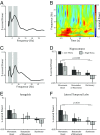Human hippocampal theta power indicates movement onset and distance travelled
- PMID: 29078334
- PMCID: PMC5699050
- DOI: 10.1073/pnas.1708716114
Human hippocampal theta power indicates movement onset and distance travelled
Abstract
Theta frequency oscillations in the 6- to 10-Hz range dominate the rodent hippocampal local field potential during translational movement, suggesting that theta encodes self-motion. Increases in theta power have also been identified in the human hippocampus during both real and virtual movement but appear as transient bursts in distinct high- and low-frequency bands, and it is not yet clear how these bursts relate to the sustained oscillation observed in rodents. Here, we examine depth electrode recordings from the temporal lobe of 13 presurgical epilepsy patients performing a self-paced spatial memory task in a virtual environment. In contrast to previous studies, we focus on movement-onset periods that incorporate both initial acceleration and an immediately preceding stationary interval associated with prominent theta oscillations in the rodent hippocampal formation. We demonstrate that movement-onset periods are associated with a significant increase in both low (2-5 Hz)- and high (6-9 Hz)-frequency theta power in the human hippocampus. Similar increases in low- and high-frequency theta power are seen across lateral temporal lobe recording sites and persist throughout the remainder of movement in both regions. In addition, we show that movement-related theta power is greater both before and during longer paths, directly implicating human hippocampal theta in the encoding of translational movement. These findings strengthen the connection between studies of theta-band activity in rodents and humans and offer additional insight into the neural mechanisms of spatial navigation.
Keywords: hippocampus; intracranial EEG; navigation; spatial memory; theta.
Conflict of interest statement
The authors declare no conflict of interest.
Figures



References
-
- Vanderwolf CH. Hippocampal electrical activity and voluntary movement in the rat. Electroencephalogr Clin Neurophysiol. 1969;26:407–418. - PubMed
-
- O’Keefe J, Nadel L. The Hippocampus as a Cognitive Map. Oxford Univ Press; Oxford, UK: 1978.
-
- McFarland WL, Teitelbaum H, Hedges EK. Relationship between hippocampal theta activity and running speed in the rat. J Comp Physiol Psychol. 1975;88:324–328. - PubMed
-
- Rivas J, Gaztelu JM, García-Austt E. Changes in hippocampal cell discharge patterns and theta rhythm spectral properties as a function of walking velocity in the guinea pig. Exp Brain Res. 1996;108:113–118. - PubMed
-
- Sławińska U, Kasicki S. The frequency of rat’s hippocampal theta rhythm is related to the speed of locomotion. Brain Res. 1998;796:327–331. - PubMed
Publication types
MeSH terms
Grants and funding
LinkOut - more resources
Full Text Sources
Other Literature Sources
Medical

